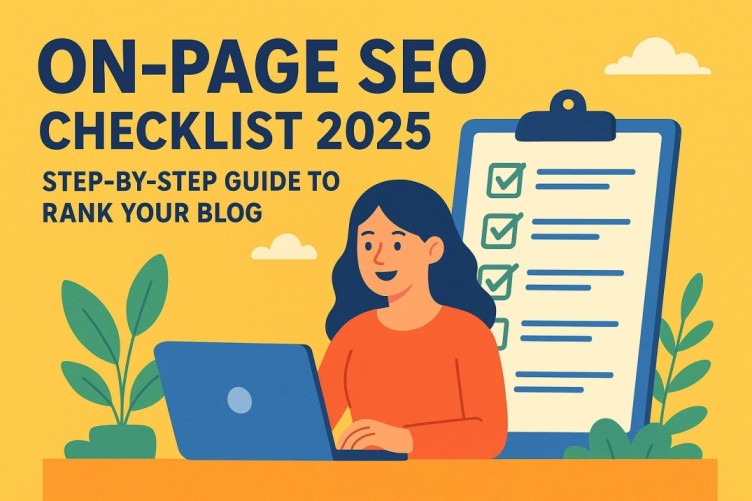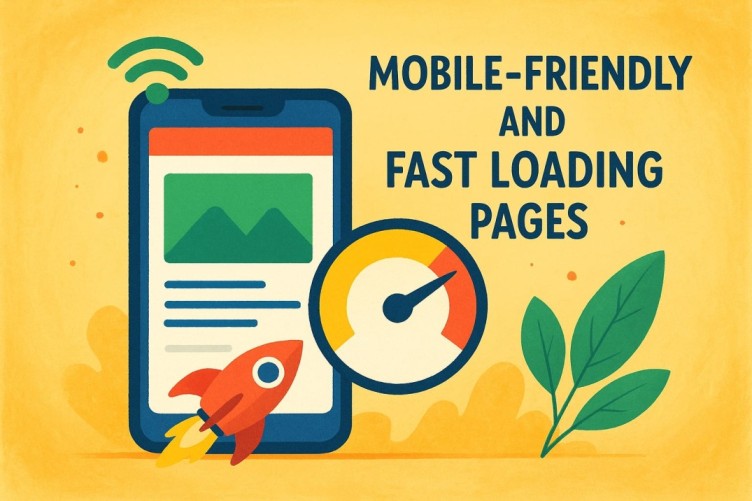Struggling to rank your blog? This On-Page SEO Checklist 2025 reveals simple steps anyone can follow to boost Google rankings, grow traffic, and monetize with Adsense.

In simple words, On-Page SEO is how you optimize your blog so that search engines understand it better and show it to the right readers. And in 2025, it’s more important than ever because Google’s algorithms are smarter, focusing not just on keywords but also on user experience, content quality, and trustworthiness.
The good news? You don’t need to be a tech wizard. This On-Page SEO Checklist 2025 breaks everything into easy, beginner-friendly steps you can follow to boost your traffic, grow your audience, and even earn from Adsense.
1. Introduction: Why On-Page SEO Matters in 2025
Imagine this: You spend hours writing a detailed, helpful blog post. You hit publish, wait for visitors to come in… but nothing happens. Your post is invisible. Frustrating, right?
That’s exactly why On-Page SEO matters. It’s what makes the difference between a blog that nobody sees and one that brings in thousands of visitors every month.
In 2025, SEO has evolved. Search engines are smarter, checking not only what you write but also how people interact with your blog. If readers stay longer, share your content, and enjoy the experience, Google pushes your blog higher in rankings.
Here’s the best part: You don’t need coding skills or expensive tools. With this simple checklist, you can optimize your blog step by step and get better results.
2. Keyword Research & Content Planning
Think of keywords as a bridge. They connect what people search for on Google with your blog post. Without the right keywords, your content is like a shop with no signboard—nobody knows it exists.
How to Do Keyword Research in 2025:
- Use free tools: Google Keyword Planner, Ubersuggest, AnswerThePublic, or even the “People also ask” section on Google.
- Focus on long-tail keywords (3–5 words): These are easier to rank and attract readers who are ready for answers.
- Example keywords:
- simple on-page SEO checklist for beginners 2025
- easy steps to rank a blog on Google
- Example keywords:
- Check your competitors: See what keywords their blogs rank for, and aim to write better, more detailed content.
Pro Tip: Don’t stuff your blog with keywords. Google hates it. Instead, write naturally, like you’re talking to a friend. Sprinkle keywords in your titles, headings, and main content, but keep it smooth.
3. Titles, Meta Descriptions & URLs
Your title and meta description are the first things readers notice on Google. If they’re boring, people won’t click—even if you’re on page one.
Title Tips:
- Add numbers or the year to grab attention.
- Keep it clear, short, and benefit-driven.
- Example: On-Page SEO Checklist 2025: Easy Steps to Rank Higher on Google
Meta Description Tips:
- Keep it around 150–160 characters.
- Include your main keyword naturally.
- Example: Learn the On-Page SEO checklist for 2025 in simple steps. Boost rankings, get traffic, and grow your blog.
URL Tips:
- Keep them short, keyword-rich, and readable.
- Example: yourblog.com/on-page-seo-checklist-2025
Remember: A catchy title and description = higher click-through rate (CTR), which Google loves.
4. Content That Engages Readers
In 2025, Google doesn’t just check if your blog has keywords—it looks at engagement. Do people stay and read? Do they share? Or do they leave immediately?
Writing Tips for Better Engagement:
- Use short sentences and simple words (aim for grade 5 level).
- Break your content into headings, bullets, and lists.
- Add stories, examples, and personal tips.
- Highlight key points with bold text or italics.
Use Proper Headings:
- H1 → Main title (only one per blog).
- H2 → Main sections (Keyword Research, Meta, Content, etc.).
- H3 → Sub-sections under each H2.
Example Structure:
- H1: On-Page SEO Checklist 2025
- H2: Keyword Research
- H3: Free Tools for Beginners
This structure makes your blog scannable for both readers and Google bots.
5. Links, Images & Media Optimization
SEO isn’t just about text. Links and visuals are powerful ranking boosters.
Internal Links:
- Connect to your own posts to keep readers on your site longer.
- Example: Link the phrase “SEO tools” to your older post about best free SEO tools 2025.
External Links:
- Link to trusted, high-authority sites like Google, HubSpot, or Neil Patel.
- This builds credibility in Google’s eyes.
Images & Media:
- Use compressed images to make your blog load faster.
- Add Alt Text with keywords (example: on-page-seo-checklist-2025.jpg).
- Include videos, infographics, or charts—they keep readers hooked longer.
Pro Tip: A single image with proper Alt text can bring traffic from Google Images search too!
6. Mobile-Friendly & Fast Loading Pages

Here’s a fact: More than 70% of readers in 2025 browse blogs on their phones. If your blog looks messy on mobile or loads too slowly, visitors leave—and Google notices.
How to Make Your Blog Mobile-Friendly:
- Use a responsive theme (adjusts to all devices).
- Test your site on desktop + mobile.
- Avoid annoying pop-ups that block the whole screen.
How to Speed Up Your Blog:
- Compress images before uploading.
- Use caching plugins (if on WordPress).
- Test speed with Google PageSpeed Insights.
A blog that loads in under 3 seconds keeps readers happy and boosts SEO rankings.
7. Advanced On-Page SEO Strategies (2025 Edition)
Once you’ve mastered the basics, here are pro-level tactics to give your blog an extra push in 2025:
Schema Markup (Rich Snippets):
- Shows extra info like star ratings, FAQs, recipes in search results.
- Easy to add with plugins like Yoast SEO or Schema Pro.
Voice Search Optimization:
- With Alexa, Siri, and Google Assistant, people now search using questions.
- Use conversational keywords and FAQs.
- Example: “What is the easiest on-page SEO checklist in 2025?”
User Experience (UX):
- Google rewards blogs with a clean, simple design.
- Use clear CTAs (Call-to-Actions) like “Read More” or “Subscribe.”
- Break long posts into smaller sections for easy scanning.
E-E-A-T (Experience, Expertise, Authoritativeness, Trustworthiness):
- Share personal experiences and real tips.
- Link to credible sources and studies.
- Keep posts updated with new stats and info.
Following E-E-A-T tells Google: “This blog is trustworthy and valuable.”
8. Tracking & Updating Your SEO Efforts
Here’s the truth: SEO is not a one-time job. You can’t just optimize a post once and forget it. In 2025, with search engine updates rolling out frequently, keeping track of your blog’s performance is essential for long-term success.
Why Tracking Matters:
- It shows which posts are performing best.
- It helps you find errors and broken links.
- It guides you on what type of content brings the most traffic.
Essential Tools for Tracking:
- Google Analytics → See traffic, bounce rates, user behavior, and most-visited posts.
- Google Search Console → Check keyword performance, fix indexing errors, and monitor impressions.
- Rank Tracking Tools (like Ubersuggest or Ahrefs free version) → Keep an eye on where your blog ranks for target keywords.
Pro Tip: Spend at least 30 minutes per week checking analytics. It helps you adjust your strategy before rankings drop.
Updating Your Blog Regularly
Search engines love fresh content. If your blog is outdated, it may lose rankings—even if it was once at the top.
How to Keep Your Blog Fresh:
- Update old posts with new stats, trends, and screenshots.
- Replace broken links with working, high-quality ones.
- Add new images, infographics, or videos for better engagement.
- Rewrite meta descriptions if they don’t bring enough clicks.
Think of updating as “watering your SEO plant.” The more love you give it, the stronger it grows.
Boosting Engagement & Social Sharing
Google notices when readers love your blog. The more they share, comment, or stay longer, the better your rankings.
Tips to boost engagement:
- Add social sharing buttons at the top or bottom of posts.
- Use CTAs like: “If this blog helped you, share it with your friends.”
- Ask readers to comment or ask questions at the end of your posts.
Remember: SEO is not just about pleasing search engines—it’s about building a community of readers who trust your content.
9. Conclusion: Why On-Page SEO is the Key to Growth
Think of On-Page SEO like planting seeds in a garden. The more care you take—choosing the right soil (keywords), watering regularly (updating), and giving sunlight (engagement)—the stronger your blog grows.
By following this On-Page SEO Checklist for 2025, you can:
- Rank higher on Google.
- Attract consistent traffic to your blog.
- Qualify for Adsense and start earning.
- Build trust and authority with your audience.
But here’s the secret: SEO is a marathon, not a sprint. You won’t see results overnight, but if you stay consistent, keep updating, and focus on providing value, your blog will keep growing month after month.
So, the next time you hit publish, don’t just rely on luck. Use this checklist, optimize your blog, and give it the visibility it deserves.
10. FAQs About On-Page SEO in 2025
Here are answers to the most common questions beginners have about On-Page SEO in 2025:
Q1. How long does it take to see results from On-Page SEO?
It usually takes about 3–6 months to see noticeable results, depending on your niche and competition level. Highly competitive topics may take longer.
Q2. Do I need coding knowledge for On-Page SEO?
No, you don’t. Most On-Page SEO tasks can be done with free tools, plugins, and simple settings. Coding knowledge is not required.
Q3. How many keywords should I use in a blog post?
Focus on one main keyword and three to five long-tail keywords. Use them naturally in your title, headings, meta description, and content without overstuffing.
Q4. What’s more important, On-Page SEO or Off-Page SEO?
Both are important, but On-Page SEO is the foundation. Without proper On-Page SEO, backlinks and other Off-Page strategies won’t have much impact.
Q5. How do I know if my On-Page SEO is working?
You’ll know it’s working if impressions and clicks increase in Google Search Console, bounce rates decrease in Analytics, and your target keywords start climbing in Google rankings.
Final Words
On-Page SEO is no longer just about keywords—it’s about creating a smooth, enjoyable, and valuable experience for your readers. In 2025, the blogs that win are the ones that combine great content with smart optimization.
So, bookmark this checklist, apply it to every post you write, and watch how your blog climbs the Google rankings step by step.
Your journey to more traffic, Adsense approval, and a loyal audience starts today.